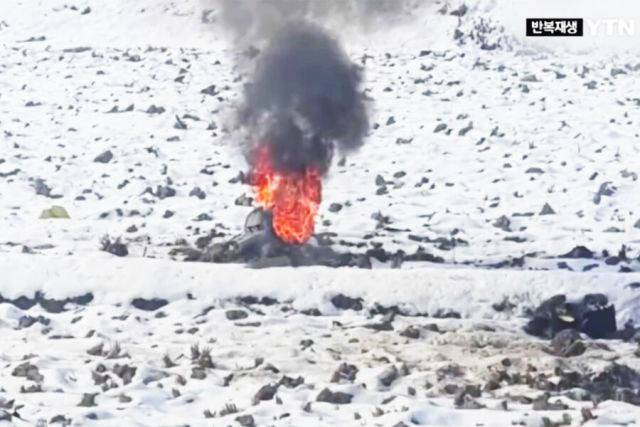The South Korean military fired about 100 rounds of 20 mm ammunition at the DPRK UAV in seven hours Five North Korean drones have crossed the border with South Korea, Seoul reports.
Attack helicopters and fighter jets were sent to destroy the drones. One attack aircraft crashed during the flight, the pilots escaped. At the same time, one drone returned to North Korea, the other four disappeared from radar.
Drones crossed the line
Unidentified flying objects, presumably North Korean drones, crossed the demarcation line dividing the Korean peninsula. This is reported by the Yonhap news agency with reference to the Joint Chiefs of Staff of the Armed Forces of South Korea.
The Armed Forces of the Republic of Korea recorded several targets in the border areas at 10:25 Seoul time (4:25 Moscow time).
Attack helicopters and fighter jets were sent to destroy the drones. According to the military, the South Korean Air Force fired warning shots, after which they tried to destroy the drones.
The plane crashed
The KA-1 light attack aircraft of the South Korean Air Force crashed during the invasion of drones from the DPRK. According to the YTN TV channel, the crash occurred at 11:40 (5:40 Moscow time) in a field near the village of Mukkeri, not far from the demarcation line.
"As a result of the appropriate response, one incident occurred. Two pilots ejected, no damage was recorded," the South Korean command reports.
According to their statement, the incident occurred "in preparation for tactical support in connection with the drones of the North."
Both pilots were able to eject and land on parachutes. They were picked up by firefighters and sent to the hospital.
Difficulties in the sky
The military of the Republic of Korea is facing difficulties in destroying North Korean drones, the News1 agency reports. Drones change their flight path and altitude, approach areas with a large number of civilians.
According to eyewitnesses, the drones are flying very low, they can be seen with the naked eye. Aircraft are actively maneuvering. Due to this, radars are not always able to detect objects, the report says.
Soon, the Yonhap news agency reported that one of the DPRK's five drones had returned to North Korea.
"In total, five North Korean drones have been identified. The first one went straight to the northern part of Seoul, and then left Seoul and returned to North Korea," the report said.
It is noted that the remaining four drones disappeared from the radars of the South Korean military.
The Air defense forces of the Republic of Kazakhstan fired about 100 shells with a caliber of 20 mm at the DPRK drones, but they could not knock them out.
In 2014 and 2017, South Korea has already reported raids by North Korean UAVs. In the spring and autumn of 2014, a total of four fallen drones were found. They found footage of the Presidential Administration of the Republic of Kazakhstan, military bases and other facilities.
In June 2017, a local resident found another crashed North Korean drone in Gangwon Province. According to the military of the Republic of Kazakhstan, the drone filmed the THAAD missile defense base of the American Armed Forces, the surrounding roads and landscapes. In total, 555 frames were found in the drone's memory.
Missile launches
In the last month, North Korea has increased the number of missile tests. On December 18, the DPRK launched two ballistic missiles towards the Sea of Japan. The launches occurred with a difference of 25 minutes. After that, three dozen more rocket launches took place.
On December 23, North Korea launched a missile again, the Japanese Defense Ministry said. Its flight range was 300 km with a maximum altitude of 50 km. The rocket fell outside the exclusive economic zone of Japan. It was North Korea's 36th ballistic missile launch since December 18. Pyongyang announced the test of its missiles.
In November, Kirill Kotkov, head of the Center for the Study of the Far East in St. Petersburg, told the Ridus news agency that a military conflict between South and North Korea is unlikely to occur due to North Korea's missile launches. He explained that both countries are too dependent on other world powers, to whom this war is not beneficial.
He recalled that there were more serious escalations between the parties. As an example, he cited the events of a decade ago, when the DPRK and South Korea conducted artillery duels in the Yellow Sea area, off the coast of the Korean Peninsula.
Ivan Zhukovsky

